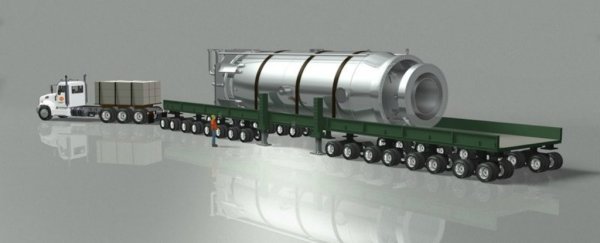The future of nuclear power might look very different than we thought, with a US-based company presenting plans for miniature, modular nuclear power plants that are so small, they can fit on the back of a truck.
NuScale Power, the company behind the power plants, says each modular device is completely self-contained, and capable of producing 50-megawatts of electricity - enough to power thousands of homes.
The power plants stand 29.7 metres tall, so aren't really that 'miniature', except relative to an acutal nuclear power plant. They also haven't been tested as yet, so we need to reserve our excitment for when we can actually see these things in action.
But the general idea is that they would be hooked together to generate power, and because each of them is self-contained, they limit the extent of any future accidents, potentially offering a safer format than we have now.
"The world's demand for electricity and clean water will increase significantly over the next several decades," said John Hopkins, NuScale Power's CEO.
"Our technology can meet that challenge with clean and reliable power, improving the environment and the quality of life for humankind."
Nuclear reactors work through the process of nuclear fission, which involves splitting atoms - usually uranium - into smaller parts.
This generates heat, which is used to produce steam and power a turbine to generate electricity that can feed straight into the grid. Almost 20 percent of the US's electricity is currently generated by the country's 99 nuclear power plants.
But these are pretty huge facilities, with giant concrete chimneys (think: The Simpsons), and the potential to produce a lot of nuclear waste. Of course, there's also the risk of a meltdown if the core gets too hot as a result of an accident.
These large-scale reactors are also getting pretty outdated. Many of the reactors in the US today soon lose their licences from the Nuclear Regulatory Commission (NRC), and all 99 of them are expected to be retired between 2029 and 2050.
So the NuScale modular power plants could offer an alternative solution. They use the same nuclear fission process to run, but they would be a lot smaller, easier to set up, and, potentially safer.
Instead of being built on site, the modular reactors which are known as small modular reactors (SMRs), would be manufactured in a factory-like facility.
Then, after production, they would be delivered to its destination and hooked up to the power grid.
Since each of the plants are modular, a town could potentially hook multiple power plants up together to provide more electricity if needed, mimicking the way we use batteries in series to power devices.
Don't think the effect is going to be subtle though - in order to generate a significant amount of power, these modular plants would need to take up a fair chunk of land.
"'Miniature' in nuclear terms is still pretty big. The modules are small enough to fit on flatbed trucks, but they would stand nearly nine stories [29.7 metres] tall," reports Geoff Brumfiel at NPR.
"Moreover, a power plant would probably require several modules hooked together like giant batteries. Of course, they'd need to be operated by professional nuclear engineers."
So what makes these new reactors so different? The team says that the SMRs will be safer than traditional nuclear power plants.
They work by having a completely contained system where the reactor is submerged in water. Unlike current plants, though, the water used to cool the reactor doesn't rely on a pump, which can fail.
Instead, the SMR uses natural convection to keep cold and hot water flowing inside the containment vessel.
While that doesn't sound like a huge deal, the devastating tsunami that struck Japan back in 2011 broke the pump that was keeping the Fukushima nuclear power plant cool, which caused a disaster that the country is still struggling with today.
Without the need for a pump in the new system, natural disasters like the one that hit Japan - or any other type of major issue in the plant - wouldn't cause nearly as much damage.
NuScale also says its reactors use less uranium than current reactors, increasing its safety even more.
Here's how it works in more detail:

Working with the US Department of Energy (DOE), the company already has plans to showcase their new reactor. They've just announced plans to build a 12-module plant in Idaho, where they'll work with power companies to test their SMR.
The team says that entire project - including the production of 12 reactors and hooking them up - will cost roughly US$3 billion.
While all of this sounds like a good thing, let's keep in mind that the design is still yet to be tested by independent researchers at this point, and there are scientists who are concerned it might not be safe.
"NuScale is proposing major reductions in all of these areas relative to current NRC requirements for large reactors, based on the assertion that the reactor will be safer," Ed Lyman, from the Union of Concerned Scientists, told NPR.
But it's important to note that none of these power plants will become active until the NRC reviews and okays them for use - a process that NuScale says will take at least three years.
If all goes well, they hope to start using the SMRs by 2026 - just in time to get everything up and running before current NRC licences expire on existing power plants.
While it remains unknown if modular power plants will play a role in the future of clean energy, it's an interesting new take on old technology. Until they start testing them, we're just going to have to wait and see.
